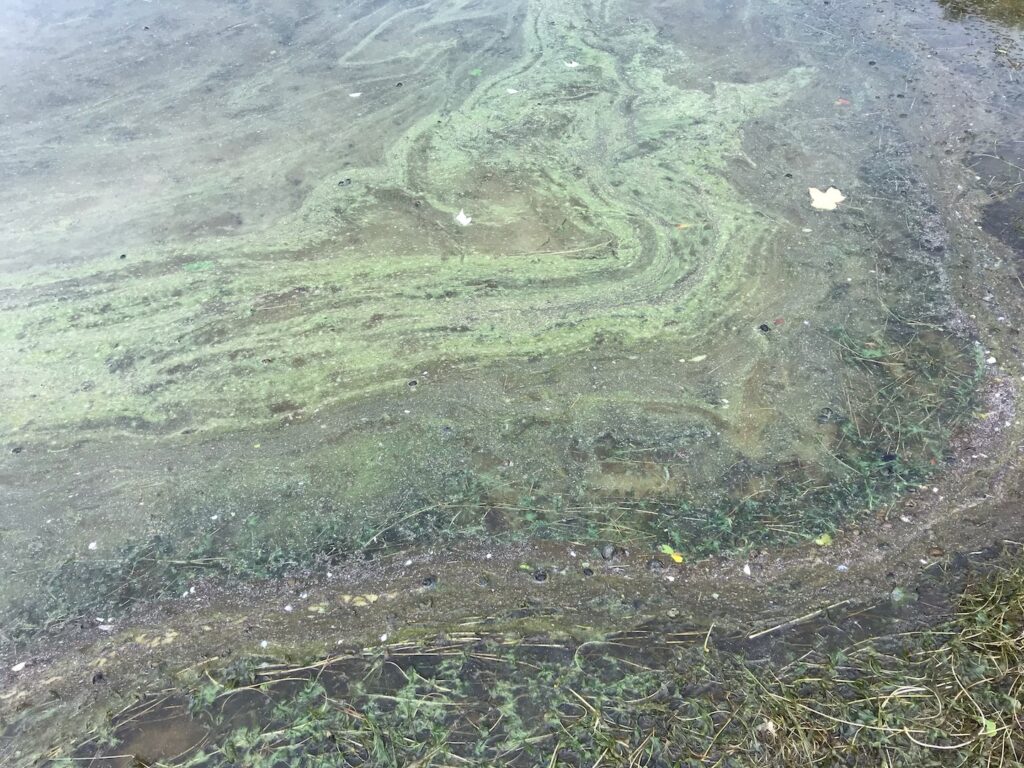Toxins in the blooms are harmful to people and animals. (N.H. Department of Environmental Services, des.nh.gov.)
New Hampshire monitors and publishes the results of fecal bacteria and cyanobacteria testing at recreational swimming locations between May 15 and Oct. 15. Signs are posted to warn the public when results exceed recommended exposure limits for children, adults, and animals.
Cyanobacteria, also known as blue-green algae, are free-floating microscopic organisms that release toxins as they degrade. Increased fertilizer use and climate warming trends contribute to the growth of these toxic blue-green algae.
When humans come into contact with cyanotoxins while swimming or boating, the U.S. Environmental Protection Agency (EPA) warns that these toxins may lead to allergic reactions, eye irritation, respiratory symptoms, gastroenteritis, and even liver and kidney failure or death. Several case studies have documented serious adverse events, including hospitalizations and organ transplants, following exposure to cyanobacteria blooms during activities such as swimming, boating, and jet skiing. Domestic animals, such as dogs, can die within minutes of drinking water contaminated by a cyanobacteria bloom. People can also be exposed by inhaling aerosolized toxins, consuming contaminated fish, or drinking contaminated water.
Fact check: Sununu claims cyanobacteria are ‘not toxic’
During cyanobacteria blooms, several toxins are released including one called microcystin. New Hampshire uses a threshold of 70,000 cyanobacteria cells/mL as a guide for when cyanotoxins may represent a danger to public health. In addition to cyanobacteria counts, Massachusetts has established a threshold of 14 parts per billion (ppb) for microcystin, while Canadian officials have set a limit of 10 ppb. These thresholds are designed to protect the most vulnerable populations, particularly children, from accidental ingestion of water during activities like swimming. Studies have shown that microcystin released during a cyanobacteria bloom can range up to 200 times the Massachusetts and Canadian limits.
Cyanotoxin exposure has been linked to debilitating amyotrophic lateral sclerosis (ALS) and other neurodegenerative diseases. ALS is a progressive neurodegenerative disease that affects nerve cells in the brain and spinal cord, leading to the gradual loss of muscle control and ultimately impacting the ability to move, speak, eat, and breathe. ALS is commonly known as Lou Gehrig’s disease, named after the famous baseball player who was diagnosed with the condition.
There is no cure for ALS and the life expectancy after diagnosis is typically 2 to 5 years. However, some individuals may live longer, with approximately 10 percent surviving for more than 10 years. Most patients ultimately succumb to respiratory failure or complications related to the disease.
Cyanotoxin exposure is suspected to have contributed to clusters of ALS disease cases in Enfield, New Hampshire, as well as in areas near Lake Champlain in Vermont, and other areas of the United States. A study estimated that 113 residents of New Hampshire were diagnosed with ALS between 2004 and 2007. From 2011 to 2018, New Hampshire had the third-highest total number of ALS cases in the United States, with approximately 6 out of every 100,000 people diagnosed with the disease.
While both Massachusetts and Vermont mandate that physicians report ALS cases and track them for disease surveillance, efforts to establish an ALS registry in New Hampshire have failed in the Legislature. The 2023 initiative to create an ALS registry (House Bill 329) received an extremely concerning unanimous bipartisan recommendation of “inexpedient to legislate” from the House Health, Human Services, and Elderly Affairs Committee, leading to the bill’s failure on the House floor in January 2024. Developing a better understanding of the spatial distribution of ALS cases is crucial for addressing the factors contributing to blooms and preventing further cases.
Given the overwhelming scientific evidence regarding the dangers of exposure to cyanotoxins, it is disheartening that Gov. Chris Sununu criticized the state environmental agency’s precautionary public health notices concerning cyanobacteria blooms on Lake Winnipesaukee. The governor claimed during a public meeting that cyanobacteria are not toxic and described the agency’s messaging as “needlessly scaring people.” The cyanobacteria warnings have now been removed from the Department of Environmental Services website.
However, the science is clear: the public deserves to be informed about the risks associated with elevated levels of toxic blue-green algae, which can pose a threat to vulnerable individuals, including children, adults, and animals. Concealing this information undermines public trust and contradicts the expectations people have of the institutions tasked with protecting them.
Note: Check before you swim or let your dog drink water here: https://www.des.nh.gov/water/healthy-swimming/healthy-swimming-mapper.

